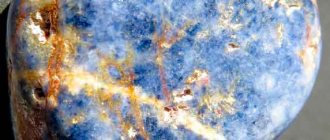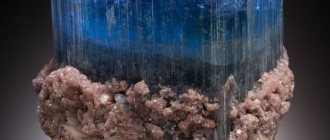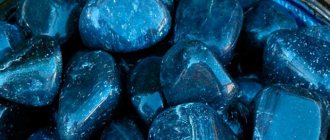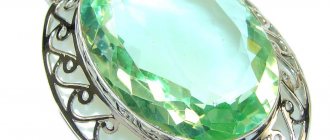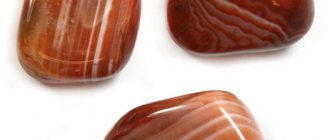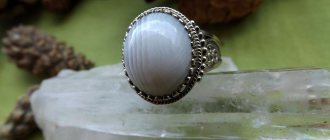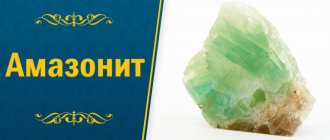Natural tourmaline is known as a mysterious and powerful mineral that was brought to Europe by Dutch sailors. Its extraordinary beauty attracts jewelers to make precious jewelry. From this article you can learn about the varieties of tourmaline, its mystical and healing properties, as well as methods for checking its authenticity.
History and origin
Tourmaline was known to the healers of Ancient Rome, Byzantium and Rus' (XIV century). Three hundred years later, Europe became acquainted with the stone. The history of the appearance of the gem on the continent is connected with Dutch sailors.
They brought these minerals from the island of Ceylon, which became fashionable. Soon, Ceylon's wealth was plundered by greedy merchants looking for “rubies” and “emeralds”.
Tourmaline
The term "tourmaline" in the local dialect means "stone that attracts ash" or "magical multi-colored stone."
The legendary gem in the form of a bunch of grapes is the “Caesar's Ruby”. According to legend, Cleopatra gave it to Caesar. Then traces of the stone were lost, it wandered around the countries until it came to the Swedish king in the 18th century. Gustav VIII presented it to Russian autocrat Catherine II.
From the day it appeared, the “bunch of grapes” was considered ruby. Only in the 20th century did they find out that this is Burmese pink tourmaline. The jewel is the property of the Diamond Fund of Russia. Another famous Russian artifact is the 500-carat stone in Anna Ioannovna’s crown.
Favorite of Emperors
Since ancient times, rubellite has enjoyed special love among those in power. It started with the famous Caesar Ruby. Later, pink and scarlet crystals adorned the crowns of Empresses Catherine I, Anna Ioannovna, and Russian Tsars Ivan Alekseevich and Mikhail Romanov.
The church tried to keep up. You can see the monstrance in the Kremlin Armory. It is decorated with pink rubellite weighing 645 carats.
The Legend of Caesar's Ruby
A legend because there is no official confirmation, but the history of the stone is beautiful and worth knowing.
The most famous rubellite in history is... ruby. Not just any ruby, but a Caesar Ruby. It has a long, often confusing, not always documented history.
It is traditionally believed that the huge (weighing more than 250 carats) gem was presented by Cleopatra (Queen of Egypt) to Caesar, her lover. True, there love affairs are mixed up with economics and politics, but that’s not what we’re talking about. Why ruby - the name rubellite arose much later. In those ancient times, red crystals were called rubies; they did not fool themselves with gemology.
Years passed, and on the ruins of the Western Roman Empire, the Frankish Empire arose, led by Charlemagne. It was he who inherited Caesar's Ruby, which was inherited by his son Louis the Pious, and was further passed on through the royal family.
Nobody probably knows how the gem got to the Templars. Maybe the king gave it as a gift, or maybe he paid it for debts... The Templars were the richest knightly and monastic order, and often lent money to kings (as a rule, they were always in need of money).
King Philip the Fair decided that everything was better than a little and on credit. Therefore, the Templars, led by the Supreme Master, burned some alive, some were carved on the wheel, some were mercifully beheaded (they weren’t even tortured).
The treasures of the Templars went to the royal treasury. And again there is a gap in the history of stone.
How the stone got to the Jesuits, instead of remaining in the royal treasury, is unclear.
The legend ends with the fact that the Jesuits gave the gem to Charles IX after the Night of St. Bartholomew. This is where the story begins. It is confirmed by documents, there is no doubt about it.
We recommend: What types of DIAMONDS are there?
The history of the most famous rubellite
After the death of Charles IX, the gem had to travel. The gem passed from hand to hand, from country to country.
List of stone owners:
- Elizabeth of Austria, widow of Charles IX.
- Holy Roman Emperor Rudolf II, brother of Elizabeth, a famous alchemist in his time.
- In 1648, the Swedes, who were at war with Bohemia at that time, captured Caesar's Ruby. Of course, the magnificent trophy was presented to the Queen of Sweden.
- Christina, Queen of Sweden; when she died, the stone was taken to Stockholm.
- And finally, Gustav III, King of Sweden, gives the stone to Catherine II.
It is clear that such gifts are not given “for nothing”. Gustav wanted political rapprochement with Russia, and was glad to marry some niece of Catherine (no matter which one, as long as it was from the imperial family).
The marriage plans did not come true, but the gem was given as a gift - there is no way to return it back.
Now the stone is stored in the Diamond Fund of Russia.
Fersman said - rubellite
Ruby, spinel - the stone was called differently. Until Academician Fersman, having examined the gem, declared authoritatively that it was rubellite. The stone was mined (according to the academician) in Burma and processed by Indian jewelers.
Physicochemical characteristics
Tourmaline contains at least 25 elements, but the chemical composition of the stone is variable.
The dominance of any impurity creates the main color of the mineral. One crystal can have several colors.
| Property | Description |
| Formula | Na(Li,Al)3Al6[(OH)4|(BO3)3Si6O18] |
| Color | Pink, red, orange-brown, green, blue, red-violet, colorless, black, polychrome. |
| Shine | Glass |
| Transparency | From transparent to opaque. |
| Hardness | 7-7,5 |
| Cleavage | Unclear |
| Kink | Uneven, small-shelled; fragile. |
| Density | 3.02-3.26 g/cm³ |
Mining locations
Valuable samples of the mineral are mined in the tracts of Brazil and Sri Lanka. There are deposits of the stone in Afghanistan, America, China, Africa and Madagascar.
On the territory of the Russian Federation, deposits suitable for tourmaline mining remain only in Transbaikalia and the Kola Peninsula. The Ural deposits are practically depleted.
Varieties and colors
The stone has several colors and shades of different values. The gem is similar to the first level precious minerals - emerald, sapphire or ruby.
Colors
In mineralogy, tourmalines of different colors are called:
- verdelite - green;
- rubellite - pink-red;
- indigolite - blue;
- dravite - yellow and orange-earth tones;
- sherl - black;
- achroite - colorless.
Green
Externally, the stone looks like an emerald, which is why it is loved by jewelers. Green crystals are found in many places on the planet, but each has its own color saturation. The most beautiful and valuable tourmalines are named after the place where they were mined, Brazilian emeralds.
Green tourmaline
Pink
The hue is created by manganese: the more of it, the brighter and more saturated the crystal. The full range of stones ranges from tea rose to purple.
Pink tourmaline
The mineral was popular with European monarchs, who ordered “almost ruby” inlay into their crowns.
The stone is mined in Madagascar, California (USA), and Russian Transbaikalia. The largest pink specimens (up to half a meter) are produced by Brazil.
Black
The mineral owes its mystical color to iron. More often used as an ornamental stone, rarely as a jewelry stone.
Black tourmaline
Blue
An expensive variety of stone of the full range. The main color, often with a greenish tint, is due to iron impurities. Deep blue shades are rare; such specimens are used for luxury jewelry.
Blue tourmaline
Due to its external similarity, the mineral is known as Siberian, Brazilian or Oriental sapphire.
The stone turns green as a result of heat treatment. Jewelers take advantage of this, presenting such tourmaline as an emerald crystal.
Brown-yellow
Also known as dravite. The second name was given in honor of the Australian Drava River, where it was first discovered. Rarely used as jewelry.
Brown-yellow tourmaline
Achroite
A colorless mineral with bluish or greenish tints.
Tourmaline achroite
Externally, achroite tourmaline is such an inconspicuous stone that no one pays attention to it. Reveals after cutting. Rare valuable species. It is found only in the vicinity of the Italian city of Elbe.
Varieties
There are several popular varieties of the mineral:
Paraiba
An expensive and bright variety of natural tourmaline, a dream for jewelers and collectors. The stone palette ranges from blue to emerald, with a neon glow effect. It's rare to find, so it's expensive. It is formed only in rocks of the Brazilian state of Paraiba.
Paraiba
Watermelon
An original representative of the tourmaline family. Watermelon tourmaline is a combination of red-pink, white and green shades flowing into each other. But clear boundaries between the colors are preserved, creating a resemblance to a slice of watermelon.
Watermelon tourmalite
Burmese
This type of natural tourmaline stands out due to its shape. The stone is cut perfectly, but the inside looks scratched. The color palette of the mineral ranges from ripe garnet to dark purple.
Burmese tourmaline
The color of the Burmese stone imitates congealed blood; it makes a pendant or pendant look impressive.
Sibirit
A deep crimson or reddish-purple variety of the stone, reminiscent of rubellite, mined in Russia.
Siberian tourmaline
Chameleonite
The stone changes color under different lighting conditions. In artificial - a reddish-earthy glow, in daylight - a green tint with an olive tint.
Necklace with chameleonite tourmaline stone
Chrome tourmaline
A bright green stone with a high percentage of chromium.
Chrome tourmaline
The color is closest to emerald, but less shiny.
Color range and varieties
With an amazing variety of colors of transparent crystals, tourmaline is one of nature's beautiful creations. This gem emits the same electrical energy as the human body pulses with a charge of 0.06 mA. It is charged with electrical energy from the Sun. There are monochromatic and polychrome minerals, with almost all the colors of the rainbow. Depending on the color, the physical properties of tourmaline may change, as well as its energy.
Varieties of tourmaline are determined by properties, color, and deposit. The varied rich palette of shades of the mineral is provided by a complex composition, which includes about 26 chemical elements of the periodic table. Popular jewelry tourmalines contain a lot of alkali metals: sodium, potassium and lithium, which ensures the variegated attractive color of the crystals. The presence of trace elements such as magnesium and calcium, manganese and iron, chromium and vanadium determines the extraordinary colors of this valuable mineral. The presence of lithium colors the stone red, magnesium gives it a brown tint, and sodium gives it a yellow tint. Iron gives black color to crystals.
The following types of mineral are known:
- Black tourmaline sherlite is an opaque mineral that contains an increased amount of iron. Bioenergetics specialists explain that this color helps to create a field around the owner that is not affected by physical radiation, helping not to be subject to mental influence. Can be processed and has an electrical charge. Helps the owner to maintain calm and a mystical mood.
- Indogilite, a variety of deep blue indigo, is universal among astrology experts. It is not inferior to sapphire in its beautiful appearance. The elements that make up the mineral determine the shades. In nature, indigolite is blue-green in color, with a shade of sky blue, similar to aquamarine. The blue gem is considered a symbol of peace and love,
- Watermelon tourmaline amazes not only with its unique beauty, but also with its hard structure and increased resistance to physical influences. The mineral has a pink middle with a green frame, reminiscent of a striped berry. Many jewelers refuse cutting and simply cut it into plates; the mineral appears in its individual unique beauty. This beautiful stone is naturally endowed with powerful energy, has the ability to emit infrared radiation that is beneficial to the human body, as well as block electromagnetic waves and ionize the air in the room.
- Rubellite is a pink tourmaline that belongs to the second class of precious gems. Rubellite is translated from Latin as reddish and is considered the most sought after variety. It has a rich palette of different shades, ranging from light pink to purple-red. Such a rich, bright shade depends on the amount of manganese in the mineral. Raspberry-cherry colored rubellite found in Siberia is called sibirite.
- Verdelite stands out among tourmaline varieties due to its beautiful green color. It is one of the noble species among tourmalines. This noble color of the stone comes from an admixture of iron compounds. Verdelite surprises mineral lovers with shades of soft grassy and dark emerald green. Unevenly distributed impurities create a bizarre play of colors in the crystals of this variety. There are verdelites whose tops are red and rubellite.
- Paraiba. The mineral has a stunningly beautiful color: rich emerald green, crimson and blue shades of a transparent structure.
- Chameleonite. As the name suggests, the mineral changes its crystal color depending on the light source. In daylight it appears emerald green, and in artificial light it strikes with an amazing red sheen.
- Burma tourmaline is called scratched. The color of the mineral ranges from garnet red to dark purple. Its peculiarity is that on the outside of the stone the surface is smooth and transparent, but inside the gem, stripes in the form of scratches are visible.
- Achroite is a colorless tourmaline of volcanic origin, a rare type of mineral, and is one of the most valuable gems. Its crystals are elongated-prasmatic, needle-shaped. It is also called Elbaite, as it was found on the Elbe River in Germany. Refers to allochromatic minerals. The stone reflects all the colors of the rainbow and is distinguished by strong pleochroism. Some crystals with needle-shaped microinclusions may have a cat's eye effect.
- Yellow tourmaline is a rare type of gem, containing a lot of magnesium and potassium, which give it such an unusual color.
- Varieties of tourmaline include dark green and brown dravites.
- Chrome tourmaline is a rich green color, similar to emerald, the mineral acquires this shade due to the increased content of chromium in its composition.
Medicinal properties
Tourmaline is unique in that its physical characteristics are also medicinal.
The Curies also discovered the identity of the electrical radiation of a mineral and the human body.
Physical parameters
The properties of natural tourmaline stone act as medicine in several areas:
- Warming up. Crushed crystals create a warming effect.
- Ionization. The mineral polarizes, ionizing the air. Negative ions speed up recovery after illness or surgery.
- Infrared radiation. Tourmaline emits infrared rays. They reach problem areas of the body, triggering cell restoration.
The healing effect does not depend on the size of the crystal; tiny stones are more effective than large ones.
Tourmaline
Color Specialization
The healing properties of tourmaline are determined by color or variety:
- green - the mineral strengthens the immune system, activates blood circulation, inhibits aging and rejuvenates; treats pathologies of the heart, kidneys or liver;
- blue - supports immunity and eliminates hormonal imbalances;
- Paraiba - the stone is beneficial for men (heals the reproductive system);
- pink, red - the gem heals the skin and lungs;
- yellow - acts as a sedative and stabilizes emotions;
- black - for the disease to go away, you need to twirl the black tourmaline crystal over the diseased area or on the skin counterclockwise.
The healing magical properties of tourmaline are a salvation for those people whose home or place of work is located in a geopathogenic zone.
Contraindications
The beneficial effect of tourmaline on the body has been proven, but there are contraindications. Medical stop factors:
- pregnancy or breastfeeding;
- problems associated with thyroid diseases;
- high body temperature;
- bleeding or hemorrhagic strokes;
- age under 12 years.
Tourmaline is placed on injured soft tissues a day later. Allergy sufferers and people with pacemakers should use the mineral with caution.
How to use it correctly?
In order for tourmaline to reveal all its magical properties and healing properties, it is worn as ordinary jewelry, not far from the heart chakra. The most successful jewelry are beads, necklaces, pendants and brooches. But rings and earrings, popular among jewelers, are not the best option for using this type of crystal.
Beads made from rubellite alone cannot be worn every day. Their influence may be too strong. The correct decoration option is beads made of pink or red tourmaline with the addition of other minerals. Stones such as rose quartz, morganite, kunzite, rhodonite, rhodochrosite, malachite, dioptase are excellent.
There are rules for using the green crystal.
- Men should wear daily. But not all the time. It's best either during the day or at night.
- Initially, the stone may cause the body to react too strongly, leading to headaches and irritability. In this case, wearing it should begin with several hours a day, gradually increasing the time to 12 or more hours.
- Women can only wear green tourmaline jewelry for a short period of time. For example, for a fitness workout. And not every day. But from case to case. Daily wear is suitable only for those ladies who suffer severely from a lack of male energy. But even they can only wear the stone for a few hours a day.
If a woman feels signs of an “overdose” of green stone, for example, she notices that she has become aggressive, overly irritable, harsh, she can neutralize the excessive influence of verdelite by decorating with pink tourmaline.
But you should never wear rubellite and verdelite at the same time.
Magic properties
The magical feature of tourmaline is the creation of a protective field around the owner.
The magic of the mineral neutralizes not only mental negativity, but also physical negativity: radiation from a TV, computer, microwave, and other electronic devices. The pebble is placed on the apparatus or next to it.
The magical effect on a person is determined by the color of the stone:
- green - needed by those who do not believe in themselves; the talisman will tell you a way out of a hopeless situation;
- red is a gem for people concerned with the attention of the opposite sex;
- pink is a popular ladies’ talisman, it pacifies, relieves self-criticism and helps to endure life’s troubles;
- watermelon - the stone will make the owner responsive and condescending to people, teach him to express thoughts correctly; will help those who have lost faith in love or have lost hope of organizing their personal life; increases libido levels, but the woman will become loving;
- raspberry - an attribute of creative people;
- lilac is a talisman for overly emotional people;
- blue is a godsend and salvation for those who put family values above all else. Crystals the color of the summer sky in silver will ensure the peace of the family nest and the inviolability of marriage bonds;
- Paraiba - the influence of the stone will help you live in harmony with yourself and the world, look into your own subconscious and relieve depression;
- achroite - neutralizer of emotional explosions;
- indigolite is an attribute of scientists, philosophers, or those on a spiritual quest;
- brown - the stone hardens spiritually and physically, a ring or bracelet makes the owner inaccessible to negativity; amulet for the elderly;
- black - sherl does not attract or emit energy, but forms a shield field around the owner from any influence (including electromagnetic waves); a ring or earrings with it are suitable for pathological jealous people, haters or similar persons to reduce the degree of emotions.
Self-respecting witches or sorcerers consider black crystals a mandatory attribute for protection from “colleagues.”
Jewelry with tourmaline stone
The magical properties of black tourmaline help you find yourself or find the meaning of life. Sherl clears her mind by focusing on her goal.
Multi-colored gemstones are chosen by well-rounded, life-loving people.
general characteristics
Pink tourmaline carries sensual energy and the element water.
It is a stone of love and friendship that teaches a person to empathize with others. It is considered a children's and feminine mineral. Normalizes the functioning of the heart chakra – Anahata. Red rubellite is also a stone of love and friendship. But unlike pink, which pacifies a person and makes him more of a calm contemplative, the red version of the mineral teaches communication. Helps develop extroverted characteristics in a person. Green (verdelite) is a crystal of creativity, monetary luck and business success. Helps turn hobbies and increases into a source of stable income. Increases physical endurance, strengthens a person’s connection with the Earth. Indigolite is a mineral of calm. Relieves stress, gives good sleep, helps not to take troubles to heart. It carries the energy of water, which removes all excessive fears and worries from life. The black version is associated with the Earth. This is the most powerful type of amulet against negative energy of all types of tourmaline. The magical properties of all tourmalines without exception are so great that they are considered shamanic stones, which are suitable for protection against the forces of Darkness during the performance of occult rituals.
Who is suitable according to their zodiac sign?
According to the horoscope, tourmaline stone suits several zodiac signs.
The color of the stone matters:
- Leo, Libra or Aries - green or pink;
- Taurus, Sagittarius or Aquarius - blue;
- Capricorn - pink;
- Scorpio is black.
For Gemini, Pisces or Cancer, a pebble of any color will suit them.
| Zodiac sign | Compatibility (“+++” – fits perfectly, “+” – can be worn, “-” – strictly contraindicated) |
| Aries | + |
| Taurus | — |
| Twins | + |
| Cancer | + |
| a lion | + |
| Virgo | — |
| Scales | + |
| Scorpion | +++ |
| Sagittarius | + |
| Capricorn | — |
| Aquarius | + |
| Fish | + |
(“+++” – fits perfectly, “+” – can be worn, “-” – is strictly contraindicated)
Varieties
Red or pink – rubellite. The most expensive option for minerals of this type.
Blue – indigolite. It is naturally dark in color. However, it is often heated to make the stone lighter. This makes him attractive.
Brown is drastic. Also often lightened.
Colorless - archroite. It is extremely rare in nature. It is obtained artificially by heating the pink mineral.
Watermelon tourmaline is pink in the center and green on the edges. Sometimes the reverse distribution of colors occurs. The photo of the unprocessed version of this mineral is not impressive, but in its processed form the stone looks very appetizing.
Black – sherl. The most common option.
Yellow and yellow-green. Does not have a separate name.
Green – verdelite. Very similar to emerald, with which it is often confused.
As with the magical properties of aventurine, the effects of stones of different colors vary greatly. The most pronounced metaphysical meanings are those of pink, red, green, blue and black tourmalines.
Application area
Purity, transparency and color saturation determine the value of crystals. Tourmaline is divided into jewelry, ornamental or technical. Each type of stone has a meaning for a person.
Jewelry
Pure transparent stones are used for jewelry. The variety of colors of the mineral allows you to choose an option for women and men of any age or color type of appearance.
- Delicate tourmaline looks good in a set. Two or three jewelry (beads and a ring or a brooch and earrings) do not overload the image.
- Monochrome items are appropriate with a business suit, while a multi-color composition is suitable for less formal events.
The stone is iridescent and looks different in different lighting. Therefore, it is better to choose jewelry with tourmaline during the day.
Gems are set in gold, silver, cupronickel or jewelry alloy. Table or cabochon cut.
Pendant with tourmaline
The cost of the stone is $20–90 per carat. Exclusive specimens (for example, a flawless Paraibe) are valued at thousands of dollars. Prices for high-quality tourmaline are rising faster than for diamonds.
Medicine
Material rejected by jewelers is not thrown away. The healing properties of such tourmaline are indispensable for medicine:
- Air ionizers are installed in the bedrooms of sanatoriums or hospitals: negative ions speed up recovery.
- The crystals generate infrared rays (rays of life, as the Japanese believe), similar to human ones. They reach the deep-lying tissues of the body, starting their normal functioning until restoration.
- Heaters with tourmaline filling are a popular tool in the treatment of joints or back diseases. The smallest mineral crystals are attached to natural fibers. Belts, scarves, knee pads, elbow pads, insoles or thermal underwear are sewn from them.
For devices, procedures or products with tourmaline, pristine, unprocessed material is used.
The stone is used in medicine because it acts comprehensively, healing the entire body.
Industry
The beneficial properties of tourmaline as a piezoelectric or pyroelectric are used in the production of electronics and optical devices.
Tourmaline chips are added to coatings to increase refractoriness.
Transparent stones “help” measure underwater pressure at significant depths.
Types of tourmaline
Artificially grown crystals are also used for technical purposes.
Health benefits and harms
Tourmaline is the only mineral that has its own electric field and is rich in beneficial microelements. This combination turns the gem into a health factory with healing properties. Medicine also recognizes the healing resource of this wonderful natural stone, and tourmaline gives good results in treatment. The beneficial properties of the mineral have a beneficial effect on the human body.
- Vasodilation improves blood and lymph flow and heart activity
- Stimulates the functioning of the heart and liver
- Vessels are cleared of atherosclerotic plaques
- The functioning of the nervous system is normalized, metabolism is improved, and the immune system is strengthened.
- Blood plasma is charged with energy, sleep and oxygen supply to cells improve.
Products with tourmaline help rapid recovery from serious illnesses and injuries. Tourmaline crystals sewn into belts, rugs, and socks have a healing effect on the spine and joints.
Important. Products with natural tourmaline crystal protect the human body from electromagnetic radiation from computers, microwave ovens and other household electrical appliances.
Despite the healing properties of the mineral and its importance for humans, we must not forget that it has the ability to influence the biocurrents of the body. If used ineptly and without knowledge of the properties of the stone, in addition to its benefits, it can cause harm. In this regard, the mineral cannot be used for:
- cancer, elevated body temperature;
- tendency to bleeding;
- pregnancy in women and breastfeeding;
- the presence of a pacemaker, skin diseases, wounds.
In case of febrile conditions or increased body temperature, you should refrain from using tourmaline products.
How to spot a fake
Glass or a cheap gem is passed off as natural tourmaline. The difference between a stone and a fake is revealed by its physical characteristics:
- It will not be possible to scratch stone, but it will be easy to scratch glass;
- tourmaline is electrified, so it is heated, squeezed in hands or tinder, then brought to hair, ashes or cut newspaper. If they stick, it's a real stone.
Particularly sensitive people, when rubbing tourmaline, feel a tingling sensation in their fingers.
Let's analyze what the mineral looks like:
- tourmalines are heterogeneous in color, an ideal stone in this regard should alert you;
- the natural mineral is endowed with pleochroism, that is, a soft color transition;
- green or black stones are less commonly counterfeited.
A synthetic mineral can be created without problems, but the process of forming crystals is expensive and unprofitable.
How to recognize a fake?
They learned to grow the stone a long time ago, but the process is so expensive and troublesome that natural tourmaline and its artificial analogue are almost equal in cost.
Much more often glass is passed off as a precious mineral, so it’s worth knowing how to identify the authenticity:
- Scratch: no marks will be left on a real stone.
- Evaluate the play of light: the natural mineral tourmaline has birefringence and strong pleochroism.
- Rub your finger: natural tourmaline becomes electrified, and you can immediately feel it.
- Heat the sample in your hands and bring the cut paper to it: if it attracts, the stone is real.
Experiments with electrification are the most reliable of those publicly available, because this is the main characteristic of tourmaline.
Only natural tourmaline has healing properties and magical qualities. Those grown artificially are deprived of them.
How to wear and care
According to astrology, every day “curates” its own stone.
Earrings with tourmaline
If you wear the gem according to the rules, the properties of tourmaline will be maximized:
- Monday - verdelite;
- Tuesday - red;
- Wednesday - sherl;
- Thursday - indigolite;
- Friday - indigolite;
- Saturday - verdelite;
- Sunday - rubellite.
Tourmaline is energetically powerful. Even if the zodiac sign is suitable, you do not need to wear this stone all the time.
The mineral does not require complex care. Washing with warm running water every two to three months is sufficient. It is advisable not to delay the procedure.
How to clean and charge?
Place under running water 2-3 times a week to wash away negative energy from the mineral.
It is best to wash the crystal in natural running water. But if this is not possible, you can use tap water.
After the tourmaline is washed, it needs to be charged. Usually, to do this, they pick it up and try to transfer their energy to the stone.
Can also be charged in moonlight.
Solar radiation also works great. However, it is not indicated for all stones.
Pink, blue, green and red crystal should not be charged in direct sunlight. Despite the fact that this procedure is beneficial for the energetic health of the mineral, it harms its appearance - it becomes discolored. But dark indigolite and schorl can be charged in sunlight
In principle, tourmaline can be cleaned and charged like most other crystals used for magical purposes.
How to protect yourself from fakes
Blue tourmaline is a stone that is not synthesized in large quantities in laboratories. This process is quite unprofitable from the economic side. Famous craftsmen use natural stones to make jewelry, while dishonest sellers replace the mineral with a cheap analogue. The substitute can be made from a polymer of the desired color or blue glass.
There are several tips to help you identify a fake in a store before purchasing a product you like:
- First you need to hold the stone in your hand for 1-2 minutes. A real crystal stays cool and you can feel it; a cheap imitation heats up over the same period of time.
- Real indigolite is capable of changing color depending on the intensity of light in the room. Imitated tourmaline made of glass and polymer has a uniform color and this does not change under any conditions.
- You should definitely look at the stone offered in the store under a magnifying glass. If the seller demonstrates a fake, you will be able to see small air bubbles inside the glass or polymer. This is not the case in natural stone.
Before purchasing, it is important to check all documents, assessment certificates and product quality.
